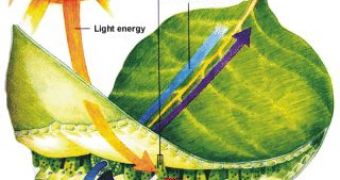This is exactly what plants do during the photosynthesis: stealing the hydrogen of the water using light. Hydrogen would be a very clean fuel, and a recent Penn State research has made a step further towards this direction.
"This is a proof-of-concept system that is very inefficient. But ultimately, catalytic systems with 10 to 15 % solar conversion efficiency might be achievable. If this could be realized, water photolysis would provide a clean source of hydrogen fuel from water and sunlight," said co-author Thomas E. Mallouk, the DuPont Professor of Materials Chemistry and Physics.
Current solar cells can now have efficiencies of over 10%, but solar hydrogen cells have much lower efficiencies due to the poor spectral response of the employed semiconductors.
Photosynthesis employs chlorophyll and other pigments to absorb visible light. Tests made with natural and synthetic pigments have delivered either hydrogen or oxygen, but the process was not continuous and it was more costly than splitting water using electricity. The main issue is that the resulting hydrogen and oxygen rapidly recombine, as the catalysts of break down reaction also boost the recombination reaction.
The new research, presented at the annual meeting of the American Association for the Advancement of Science in Boston, developed a catalyst system that, applied to the pigments, it can induce the same electron transfer and water oxidation from photosynthesis. The center catalyst is made of iridium oxide molecules wrapped in orange-red pigments. These clusters are about 2 nm wide, the catalyst and the pigment part being about the same size.
The orange-red pigments absorb the blue light, carrying most of the energy. When light hits the pigment, the energy excites the electrons of the pigment molecule, which boosted by the catalyst, break down the water into free oxygen and hydrogen. "Each surface iridium atom can cycle through the water oxidation reaction about 50 times per second. That is about three orders of magnitude faster than the next best synthetic catalysts, and comparable to the turnover rate of Photosystem II in green plant photosynthesis," said Mallouk.
The titanium dioxide was used as the anode, and a platinum as cathode. The electrodes were immersed in a salt solution, but separated to impede the hydrogen and oxygen recombining. Light had to reach only the pigment-titanium dioxide anode so that the system would work.
Water splitting needs 1.23 volts, and the current device cannot reach this value, that's why 0.3 volts were added from an outside source. This system has an efficiency of about 0.3%.
"Nature is only 1 to 3 % efficient with photosynthesis. Which is why you can not expect the clippings from your lawn to power your house and your car. We would like not to have to use all the land area that is used for agriculture to get the energy we need from solar cells," said Mallouk.
Further research could change spherical pigment catalyst complexes to a geometry increasing the reaction area, and better pigments and catalysts could be found.
"The question is how to get the electrons to stay in the proper path and not, for example, release their energy and go down to ground state without doing any work," said Mallouk.

 14 DAY TRIAL //
14 DAY TRIAL //